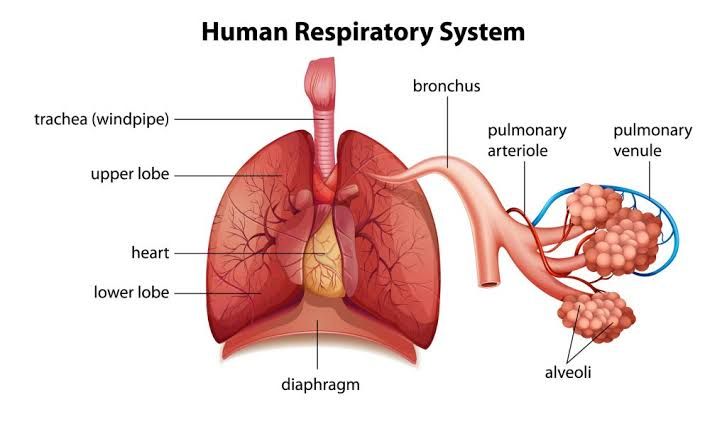
General Structures and Organs of the Respiratory System
The respiratory system is a complex network of organs and structures that facilitate breathing, gas exchange, and other vital functions. It can be divided into two main parts: the upper respiratory tract and the lower respiratory tract, each with distinct components.
Upper Respiratory Tract
- Nose and Nasal Cavity:
- The nose serves as the primary entrance for air into the body.
- The nasal cavity is divided by the nasal septum and contains bony projections called conchae, which increase surface area to warm, humidify, and filter incoming air.
- Mucous membranes line the nasal cavity to trap debris and pathogens.
- Paranasal Sinuses:
- Air-filled spaces in bones (frontal, maxillary, sphenoidal, ethmoidal) surrounding the nasal cavity.
- These sinuses lighten the skull’s weight, produce mucus, and help warm/humidify air.
- Pharynx (Throat):
- Divided into three regions: nasopharynx (airway only), oropharynx (shared passage for air/food), and laryngopharynx (connects to esophagus/larynx).
- Contains tonsils that trap pathogens entering through inhalation or ingestion.
- Larynx (Voice Box):
- Located below the pharynx; connects it to the trachea.
- Houses vocal cords for sound production.
- Includes cartilage structures like the thyroid cartilage (“Adam’s apple”) and epiglottis, which prevents food from entering the airway during swallowing.
Lower Respiratory Tract
- Trachea (Windpipe):
- A tube supported by C-shaped cartilage rings to prevent collapse.
- Lined with pseudostratified ciliated columnar epithelium that traps debris in mucus and moves it upward toward the throat for expulsion.
- Bronchial Tree:
- The trachea branches into right and left primary bronchi at a structure called the carina.
- Bronchi further divide into smaller bronchioles that lack cartilage but have smooth muscle to regulate airflow.
- Lungs:
- Paired organs located in the thoracic cavity; each lung is divided into lobes (three on the right, two on the left).
- Contain alveoli where gas exchange occurs.
- Alveoli:
- Tiny grape-like sacs surrounded by capillaries.
- Composed of Type I cells for gas diffusion and Type II cells that secrete surfactant to reduce surface tension.
- Diaphragm:
- A dome-shaped muscle beneath the lungs responsible for creating negative pressure during inhalation by contracting downward.
Comparison of Structure and Function Across Different Parts
- Upper vs Lower Respiratory Tracts:
- The upper respiratory tract primarily filters, warms, humidifies air, while also serving as a passageway for airflow.
- The lower respiratory tract focuses on conducting air deeper into lungs (conducting zone) and facilitating gas exchange in alveoli (respiratory zone).
- Conducting Zone vs Respiratory Zone:
- The conducting zone includes structures like nose, pharynx, larynx, trachea, bronchi/bronchioles that transport air but do not participate in gas exchange.
- The respiratory zone begins at respiratory bronchioles leading to alveolar ducts/sacs where oxygen diffuses into blood while carbon dioxide exits.
- Alveoli vs Bronchioles:
- Alveoli are specialized thin-walled structures optimized for diffusion due to their large surface area (~70 square meters in adults).
- Bronchioles are muscular tubes regulating airflow but do not directly participate in gas exchange.
- Nasal Cavity vs Pharynx/Larynx:
- The nasal cavity filters particles via mucus/cilia; its conchae ensure turbulent airflow for better warming/humidification.
- The pharynx/larynx act as conduits while preventing food entry into lower airways via mechanisms like epiglottis closure during swallowing.
Essentials of the Respiratory System
The primary function of this system is gas exchange—oxygen intake for cellular respiration and carbon dioxide removal as a metabolic waste product. Additional roles include:
- Maintaining acid-base balance by regulating CO2 levels in blood.
- Protecting against pathogens through mucosal barriers/cilia action.
- Facilitating speech via vocal cords in larynx.
- Sensing odors through olfactory receptors in nasal cavity.
The process involves coordination between multiple systems such as circulatory (transporting gases) and muscular systems (diaphragm/intercostal muscles enabling ventilation).
Anatomical & Functional Subdivisions
Anatomical Subdivisions
- Upper Respiratory System: Includes external nose/nasal cavity, paranasal sinuses, pharynx, larynx.
- Lower Respiratory System: Includes trachea, bronchial tree (bronchi/bronchioles), lungs/alveoli.
Functional Subdivisions
- Conducting Zone:
- Structures: Nose → Terminal Bronchioles
- Function: Transport/filter/moisten/warm incoming air; no direct role in gas exchange.
- Respiratory Zone:
- Structures: Respiratory Bronchioles → Alveolar Sacs
- Function: Gas exchange between alveoli/capillaries via simple diffusion across thin membranes (~0.5 µm thick).
By dividing anatomically/functionally this way, we understand how different parts specialize either in preparing air or exchanging gases efficiently.







